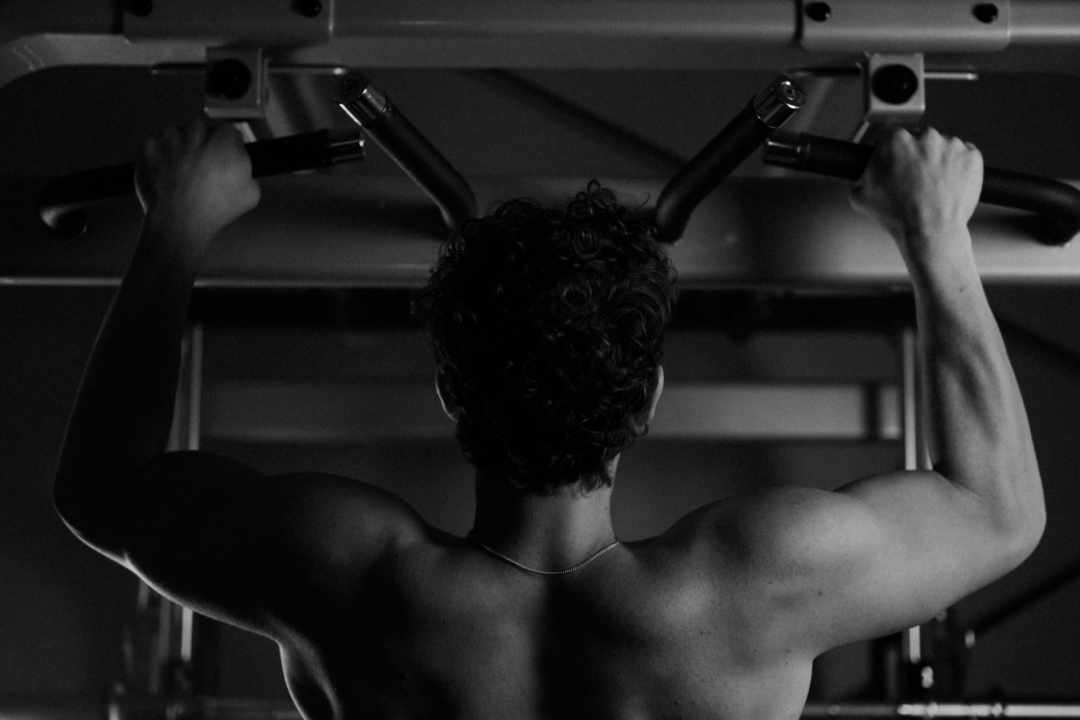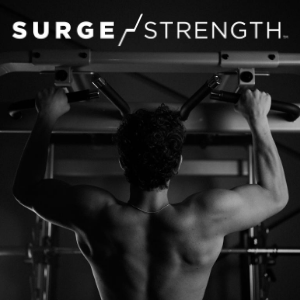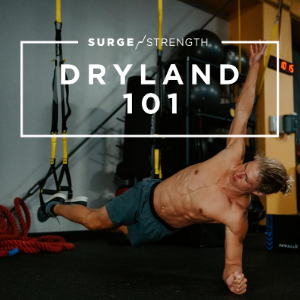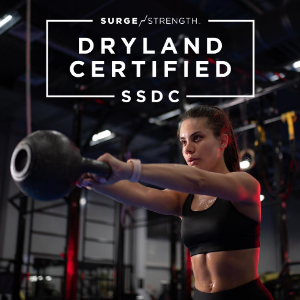Pull-ups for swimmers are a fundamental resistance training exercise. This is because the pull-up movement is very similar to the vertical pulling motion swimmers complete in any of the four strokes. Pull-ups increase upper body strength, specifically in the back muscles. The back muscles, namely the latissimus dorsi, which is commonly known as the “lats,” are also the prime movers of the pull in the water.
In dryland, pull-ups are an easy go-to for exercise prescription not only because they are swim specific but because they are versatile, simple to teach, and easy to progress or regress based on how well the athlete can perform them. A swimmer’s ability to do a pull-up is also a great indicator of their mass to strength ratio which is very important in a sport like swimming where drag and resistance play a big factor in success.
In this article, we are going to discuss how to test the pull-up ability of a swimmer who can or can’t perform a pull-up, and analyze the results so they can be used as a reliable modality when measuring an athlete’s upper body strength as well as a marker for their dryland workouts and overall program.
Pull-ups for Swimmers Test
Before starting the pull-up test, make sure the athlete is warmed up, but not fatigued. For more accurate results, perform the same warm-up routine before the test every time and try to test at the same time of day. Once the athlete is warmed up and ready to go, they are going to use an overhand grip. This means that both palms are going to face out and thumbs are going to wrap around the bar.
Next, the athlete is going to pull their whole body up, while staying vertical, until their entire chin is above the bar without using momentum. Ideally, the athlete should be hanging from a bar tall enough that their feet cannot touch the ground when they are starting the movement. Either way, make sure their feet are up and they are not jumping into the first rep. When the athlete lowers back down, make sure their arms are completely straight at the bottom of the rep and they make it all the way back down to the starting position. Repeat until the athlete either cannot get their chin above the bar or if their form becomes unsafe. Record the reps so improvements can be seen when re-testing the pull-up in the future.
Testing Swimmers that Can’t Perform Pull-ups
If the athlete cannot perform a pull-up, the flexed-arm hang is an alternative test that can be substituted for more valid results. The flexed-arm hang is an alternative measure where the athlete simply hangs with their chin above the bar, using an overhand grip for time. To help them out, consider placing a box under the athlete’s feet so they can get into a good starting position for the test. The coach can also boost them up for support if needed. The timer starts when the athlete’s chin is above the bar and is finished when the chin sinks below the bar. We recommend explaining the parameters for both tests before any attempts are made for more accurate results.
Analyzing the Scores
Once tests have been performed on pull-ups for swimmers it’s important to see what the results are. Other than being able to clearly see an athlete’s strength improvements over a given period of time, exercise testing allows dryland coaches to create more individualized exercise programs that better address an athlete’s current fitness level.
In the SURGE Strength Dryland Certification Curriculum, the pull-up testing results are divided into three levels of ability:
- Level 1 includes males who completed less than 5 reps and females who completed less than 3 reps.
- Level 2 includes males who completed 5 or more reps and females who completed 3 or more reps.
- Level 3 is any male who completes more than 15 reps or any female who completes more than 10 reps.
Each level has corresponding exercises that match the ability of the athlete’s pull-up capacity.
For athletes that completed the flexed-arm hang, we can categorize the results based on how long they were able to hang from the bar.
- If the athlete, male or female, can hang for a minute or longer, they are most likely ready to start training pull-ups.
- If they can hold for 30 seconds to a minute, they are still developing the strength needed for pull-ups.
- If they could only hold for less than 30 seconds, their upper body strength needs addressing through daily strength-building movements.
This data tells the coach how much work the athlete needs when it comes to the vertical pulling action and what movements should be programmed to make the athlete stronger.
Conclusion
No matter what level of athlete you have, pull-ups for swimmers is a critical objective to measure dryland workout success. Objectively knowing the upper body pull strength of an athlete helps the coach zero in on their dryland workouts level of programming. If they are considered a Level 3, coaches may start weighted pull-ups by using a weight vest or having the athlete hold a dumbbell between the feet. If they are a Level 2, the coach may simply start prescribing more pull-ups in order to get them to move up to that Level 3 capacity.
If they are classified as a Level 1, maybe the coach opts for a band or partner assisted variation of a pull-up. Or, they can train just the eccentric lowering phase of the movement. For athletes who are still working up to being able to do pull-ups, there are many alternative exercises that can be implemented that will build the upper-body pull strength so that the athlete can complete their first “real” pull-up. The less time the athlete could hang from the bar will indicate how much attention should be placed on training the back muscles and the vertical pulling motion.
After training the pull-up, it’s time to retest. Typically, coaches test athletes before a new season starts, mid-season, and at the end of the season. Coaches may also test more frequently, such as between periodized blocks of programming or at the end of each mesocycle of training. Regardless of when coaches choose to retest, it is important to see improvement and adjust the swimmer’s dryland workouts accordingly.
If the athlete is not injured and not improving, this tells the coach that something in their program is not working. If the athlete is improving, the coaches can take a closer look to see what is contributing to these results. A better pull-up out of the water is going to allow for a better pull stroke in the water. A swimmer who is able to develop a stronger pull in dryland is going to move better and faster in the water and ultimately drop time in their race.
Next Steps
If you have an athlete that isn’t able to do even a single pull-up and/or is very weak on the flexed-arm hang, it can seem like a monumental task to help them accomplish a single pull-up.
Enroll now for FREE in the SURGE Strength Academy and take the Dryland 101 Course: Building the Pull-up to learn the exact progression you can take an athlete from any level to being able to do multiple pull-ups. Check out what others are saying about this Dryland 101 Course:
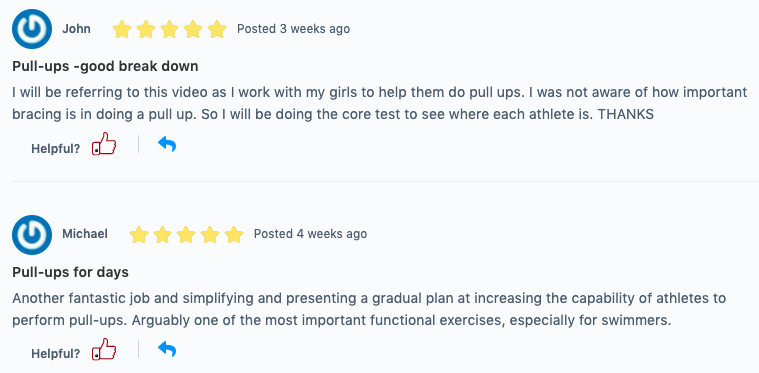
ENROLL NOW FOR FREE IN THE SURGE STRENGTH ACADEMY
BECOME SURGE STRENGTH DRYLAND CERTIFIED (SSDC)
BUILD BETTER ATHLETES TO GENERATE FASTER SWIMMERS
Courtesy of SwimSwam’s exclusive dryland training partner, SURGE Strength.
SURGE Strength, a strength training brand created by Chris Ritter, CEO of RITTER Sports Performance, aims to build better athletes and faster swimmers through dryland programs, and coaching education.
